"Midnight Hammer" - a Fordow's Bunker Buster or just Busted [i]
The USA Bombing of the Iranian Nuclear Facilities - Aftermath
The United States has conducted a series of airstrikes targeting key Iranian nuclear facilities - specifically, three high-value sites, with at least seven B-2 Spirit bombers as well as a salvo of Tomahawk cruise missiles launched from submarines. In total, 14 GBU-57A/B Massive Ordnance Penetrators (MOPs) ( 12 for Fordow and 2 for Natanz) were deployed, along with 30 cruise missiles.
According to President Trump, who often portrays himself as a strongman unafraid to use force, the operation was extremely successful and all goals achieved, meaning the Iranian nuclear program went up in ashes. However, beneath the rhetoric and posturing, serious doubts remain about whether such strikes could meaningfully degrade Iran’s nuclear capabilities, especially when it comes to deeply embedded sites like Fordow. cspsbilities
At best, this could amount to little more than strategic theater, a carefully orchestrated display of power aimed at sending a political message rather than achieving lasting military results. In effect, the U.S. may have executed a strike based on an Israeli wish list: using bombs to project strength while avoiding actions that could trigger broader conflict.
For neoconservatives and proponents of an aggressive foreign policy, such a scenario would be hailed as a success—proof that decisive military action can shape geopolitical outcomes. Yet, Iran, a nation known for its strategic patience and resilience, chose to respond publicly in a controlled manner, targeting the US bases in Qatar. What will happen next is that they quietly assess the damage, reinforce their underground infrastructure, and continue their nuclear work beyond the reach of even the most powerful conventional weapons.
The world may be led to believe that the “threat” has been neutralized, for now. But history suggests that such illusions rarely last. Eventually, the same concerns will resurface, bringing the crisis back into the global spotlight.
“The roaring mountain just gave birth to a mouse.”
In the case of a high-profile strike, such as the one on Fordow, the symbolic value often overshadows the physical outcome. A site as hardened and deeply buried as Fordow—originally constructed within a mountain to withstand conventional attacks. It can’t be easily neutralized even with specialized munitions like the MOP or a direct hit from a hypersonic ballistic missile.
Yet, even then, the effectiveness depends on:
Intelligence accuracy: Was the target still active?
Timing: Was the infrastructure recently evacuated or relocated?
Munition capability: Did the weapon used have sufficient penetration depth and explosive yield?
If the facility was decommissioned, emptied, or redundant, then the operation becomes more about message than material damage, a geopolitical performance aimed at deterring adversaries and reassuring allies.
Optical Effect Over Outcome
Such events often produce more theater than transformation. The media cycle amplifies the action, leaders issue statements of resolve, flags are waved, and bombs and missiles are launched - but the real question remains: What was actually destroyed?
This is where the gap between perception and reality widens. If core infrastructure remains intact or the targeted regime adapts quickly, the long-term strategic balance may not shift significantly. In this light, the operation resembles a symbolic punctuation mark in an ongoing diplomatic struggle rather than a decisive blow.
While political rhetoric and military parades dominate headlines, financial markets often act as the first honest arbiter of whether a crisis has real economic consequences, including:
A spike in oil prices could signal concerns over regional stability.
Currency fluctuations could reflect investor confidence (or lack thereof) in involved nations.
Defense stocks may rise on expectations of increased military spending.
Markets don’t care about slogans or intercepted missiles shown in shaky phone videos; rather, they react to risk, uncertainty, and real shifts in power dynamics. So far, as the punches were exchanged, the market is not reacting “violently”.
The Depth
How deep is Fordow?
Open sources provide at least three distinct estimates for the depth of the Fordow facility: approximately 60–90 meters, 80–100 meters, and even up to 500–800 meters. These discrepancies arise from differences in measurement methodologies, limitations of satellite imagery, and deliberate information obfuscation by the Iranian government. Until engineering plans are leaked or the IAEA gains direct access to the site for inspection, the precise depth of Fordow remains uncertain.
Still, it is worth examining why Iran might engineer such a deeply buried facility, possibly extending toward the half-kilometer mark, and why that possibility alarms the Pentagon more than it does Israel.
The 60–90 Meter Estimate:
Outlets such as Deutsche Welle, Economic Times, and the Foundation for Defense of Democracies (FDD) estimate Fordow's depth based on the thickness of the mountain rock layer above the main halls. In practical terms, this reflects the vertical cover, like measuring the height of “floor-1” from the surface. Their estimates place the depth at 60–90 meters.
The 80–100 Meter Estimate:
Moneycontrol cites a slightly deeper figure, likely accounting for a broader interpretation of structural depth rather than just the overhead rock.
The ~100 Meter Estimate via Satellite DEM:
Bloomberg reportedly used digital elevation models (DEMs) from commercial satellite imagery (Planet Labs and Maxar) to measure the distance from the entrance tunnel’s opening to the presumed facility roof. This method places Fordow around 100 meters deep. However, it should be noted that small angular errors, such as a ±3° deviation in tunnel slope, can introduce measurement discrepancies of dozens of meters. Additionally, some sources introduce further variance when rounding feet to meters.
Given these limitations, depth estimates are best treated as approximations unless corroborated by direct data.
Iranians are very capable of carrying out any of the previously mentioned deeds. They experience gained in mining projects, including copper and iron mining projects, in the Zagros Mountains. They have mastered the technology of drilling rotating, spiral tunnels with a diameter of up to 6 meters. This technology allows the construction of deep complexes without complex ventilation systems.
Iranians are highly suspicious of the IAEA and its connection with the Mossad and CIA, so they never disclosed design drawings of Fordow.
Going Through the Rocks
The Fordow enrichment facility is located beneath a mountain ridge, approximately 80–90 meters (260–300 ft) underground, though some sources estimate even deeper construction.
Fordow is not merely underground; rather, it is embedded in terrain specifically selected to resist kinetic strikes. This “geological armor” is not a flaw in design but a calculated feature of strategic protection.
It is surrounded by:
High-compression rock, such as granite or volcanic basalt
Engineered voids and shockwave traps
Entrances that are designed to collapse inward, not allowing breach access
Multiple physical redundancies are designed to isolate sections from collapse
Strikes designed to "go through the rock", such as those targeting deeply buried facilities, require careful assessment of multiple variables. Key considerations include the type and thickness of overburden material, the penetration performance of the weapon, and the probability of neutralizing the actual target beneath.
Kinetic Energy Limitations The kinetic energy of the GBU-57 is enormous, but not infinite. The MOP isn’t a high supersonic at ground impact; its velocity (~Mach 0.9–1.2) limits the kinetic energy needed for deep penetration into compressive, non-brittle rock. Upon impact with solid rock, the bomb must transfer that energy to displace or fracture material. The efficiency of this transfer depends heavily on the target’s properties:
Granite has a compressive strength of 130–230 MPa
Basalt exceeds 200 MPa
High-density rock absorbs and deflects shockwaves
Kinetic energy dissipates rapidly in a radial pattern
The deeper the target, the more energy is lost in transferring the blast force. Energy disperses quickly in rock, not in a focused shaft like concrete.
In the relatively soft soil material, the MOP forms a narrow, deep penetration tunnel. Against hard rock, the impact resembles a shallow crater due to energy dispersal and shattering resistance. Rather than slicing through layers, the bomb impacts, shatters the first few meters, and loses momentum.
It is well known from rock fracture dynamics that hard rocks, such as granite, fracture and absorb impact energy unevenly. After initial impact, the shock wave dissipates radially, reducing penetration efficiency. Hard rock, such as granite, is not ductile. Upon high-velocity impact, it fractures in chaotic, energy-absorbing patterns, which significantly reduce the forward energy transfer. This further limits depth penetration.
Impact angle sensitivity dictates that even minor deviations in impact angle result in reduced penetration depth. Sloped terrain or rock layering can cause deflection or premature detonation.
While multiple hits might theoretically deepen the impact tunnel, precision placement is nearly impossible due to shock debris from the first hit, loss of GPS/INS accuracy under hardened bunkers, and surface shifts or collapse that obscure the impact point.
One may argue that if the U.S. Air Force is able to achieve multiple hits at the same point, it could gradually increase the penetration depth. However, this works only in theory, and in mass media fantasies promoted by networks like CNN and FOX. In practical terms:
The first hit collapses the immediate area
Subsequent bombs cannot follow the same trajectory
Cavity/tunnel alignment is lost
Fragmented rock layers and shock deformation scatter energy instead of funneling it
It is essential to acknowledge that Iran has not remained passive in the face of potential military threats. Tehran has actively pursued a layered defense strategy rooted in strategic deception and physical hardening, aimed at mitigating the impact of precision airstrikes, especially those involving bunker-busting weapons, such as the MOP. Some of the measures that they took are:
Filling tunnel entrances with rock and soil to absorb blast energy and prevent deep-penetration weapons like the Massive Ordnance Penetrator (MOP) from reaching critical areas;
Constructing false chambers and decoy facilities to mislead intelligence assessments and divert attacks away from real, high-value targets.
Employing shock-isolated construction techniques, such as reinforced bunkers and deeply buried, segmented infrastructure, to preserve key operational zones even in the event of a successful strike, and
Relocating sensitive materials, personnel, and equipment ahead of anticipated attack windows to minimize damage and maintain continuity of operations.
Going Through the Ventilation Shaft
Hitting a ventilation shaft does not mean a deep penetration was achieved. Ventilation shafts in secret underground military bunkers are not merely technical necessities; they are critical components of survivability, carefully engineered with redundancy and deception in mind.
Underground military facilities must support:
Sustained human occupancy
Electronic equipment cooling
Air quality management (CO₂ removal, O₂ replenishment)
Overpressure control (in case of blasts or chemical attacks)
Without ventilation, even the most secure bunker becomes uninhabitable within hours or days.
Underground military facilities—especially ones as strategically important as Fordow or similar hardened structures—are not designed with straight, vulnerable lines. Ventilation systems are purpose-built with redundancy, deception, and survivability in mind:
Shafts are rarely straight. They often follow angled, zigzag, or tiered pathways, minimizing the chance of a direct kinetic strike traveling deep enough to cause systemic damage.
Decoy shafts are common. Many are deliberately constructed as false targets, designed to absorb or mislead incoming munitions. These decoys can mimic real ventilation signatures (thermal, acoustic, airflow) and even include dummy infrastructure visible to reconnaissance.
Shaft geometry is tactical. Real ventilation lines may include horizontal-to-vertical combinations, internal blast baffles, or reinforced choke points designed to contain damage locally, even in the case of partial penetration. Some advanced bunkers use distributed micro-vent systems, employing narrow ducts spread over wide areas rather than one or two large shafts. These are harder to detect or block.
The subsurface ventilation strategy in military-grade bunkers is designed to withstand partial collapse, maintain airflow, and isolate damaged sections, thereby ensuring the survivability of the larger system.
In a post-attack briefing, the US General Caine said that Iran placed cement caps at the top of the ventilation shafts to the site. The initial U.S. airstrikes knocked out the cement caps. Several subsequent strikes dropped bombs down the ventilation shafts, where they exploded deep underground.
So, claims of "ventilation shafts being hit" should be viewed with skepticism unless accompanied by clear, verifiable evidence that a bomb not only found the shaft but survived the entry trajectory, avoided decoys, and managed to travel deep enough—likely dozens if not hundreds of meters—to inflict real damage.
Ventilation systems in these facilities are not weaknesses—they’re traps for analysts and attackers who don’t understand how deeply engineered these underground networks are.
Hitting a shaft may temporarily disrupt operations, but it’s unlikely to destroy or disable the entire facility due to its layered design and redundant airflow systems.
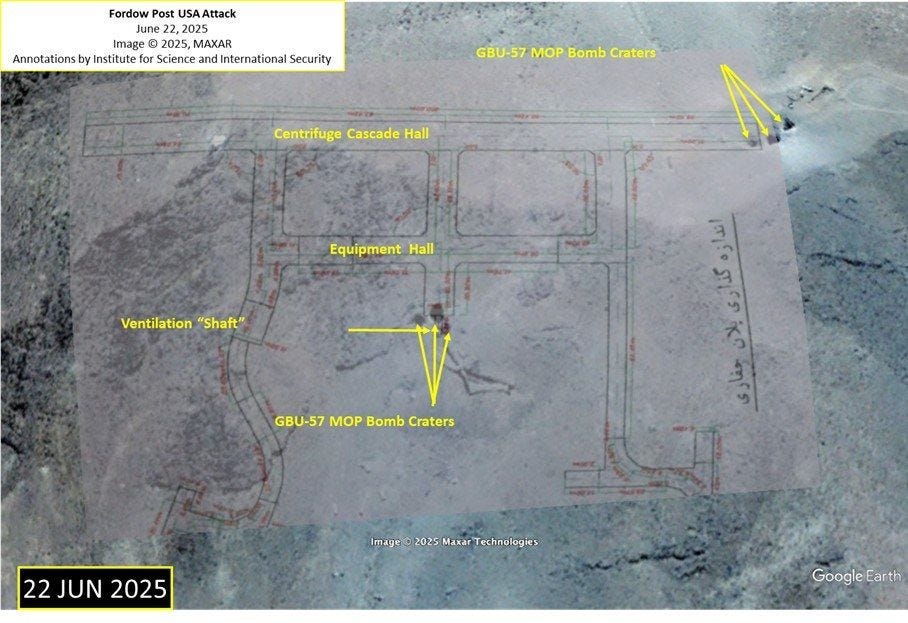
“Micro Earthquake”
What is also important during the hit of the underground structure is the seismic effect that the explosion will cause.
After the shock wave (SW) reaches the surface of the ground, surface waves begin to propagate from the epicenter of the explosion. The reason for the appearance of surface waves is the mass velocity of the surrounding material particles behind the shock wave front. After the SW passage, the particles, moving by inertia, pass their equilibrium position and return to their original position.
As a result, there are longitudinal oscillations of particles along the direction of the SW movement. At the same time, in the directions perpendicular to the SW movement, transverse oscillations of particles arise, connected with the resistance of solid bodies to change their shape.
The joint action of longitudinal and transverse vibrations of particles causes a surface seismic wave (Rayleigh wave) to be propagated along the free surface of the ground from the explosion epicenter. The point is that particles located on the ground surface experience less resistance from the surroundings during their movement than particles located at depth, because in the first case, the contact area of particles with the ground is almost twice as small.
The seismic wave causes oscillations of particles outside the fracture radius, i.e., in the elastic deformation zone. Recording the horizontal displacements of particles under the action of seismic waves makes it possible to obtain the so-called explosion seismogram. Initially, the recorder will discern the forced oscillations of the soil in response to the SW. The period of these oscillations corresponds to the elastic deformations of the surrounding material at the shock front (τ = 0.005–0.050 seconds). This phase of oscillations is referred to as the onset. After 1–10 seconds after the beginning of the entry phase, the main phase of free particle oscillations, which is a seismic wave, begins.
Multilayered Protection
Let’s now analyze the combination of penetration through the solid rock and concrete structure that protects the underground space.
Firstly, nobody knows what kind of concrete is installed, its thickness, or shape, so everything is a very wide range of assumptions.
In the article titled “Deflection of Projectile Penetrating into Composite Concrete Targets,”1 researchers analyzed the behavior of solid penetrators striking composite concrete structures with specialized geometries, such as diamond-shaped layering. A key finding of the study was that the internal structural design can significantly influence the trajectory of incoming projectiles, often inducing measurable deflection and reducing the effectiveness of penetration.
In the idealized scenarios often promoted by ordnance manufacturers—such as the case with the GBU-57A/B—marketing materials typically present best-case performance. These “analyses” assume a 90-degree impact angle, a perfectly perpendicular trajectory, and homogeneous material composition beneath the point of impact. This narrative, readily accepted and propagated by lobbyists, lawmakers, and technically underinformed decision-makers within the U.S. defense establishment, simplifies the complexities of real-world engagement.
However, such assumptions disregard the possibility of engineered deflection mechanisms within underground structures. If a target facility incorporates composite concrete with embedded deflection layers—specifically designed to induce angular deviation—the bomb’s path could be subtly or substantially redirected. Even if the GBU-57 were to miraculously pass through 100 meters of dense granite, these deflection barriers could still redirect the penetrator away from critical infrastructure, causing it to detonate in less vulnerable zones. This makes the difference between a symbolic impact and a mission success.
An excellent article discussing this issue (Reference 1) presented both theoretical and practical simulations. The conclusion drawn from the experiment was that, based on comparative results of penetration into concrete targets, with and without the diamond-shaped moving target, at an impact velocity of approximately 400 m/s, the projectile was effectively deflected by the diamond-shaped moving target. As a result, the penetration depth into the concrete was reduced, thereby improving the protective performance of the target plate.

Conclusion
Israel, acting without direct U.S. involvement, does not possess the necessary means to guarantee the destruction of the Fordow facility, even if its depth is “only” around 90 meters. While Israel has advanced airpower and precision munitions, it lacks the deep-penetration capability required to reach and neutralize such hardened underground infrastructure.
By contrast, the United States is undoubtedly capable of achieving a “mission kill”—disabling the site by targeting entrances, ventilation systems, and power nodes. However, a “layout kill” (the complete structural destruction of the underground halls) can only be reliably achieved if the facility is no deeper than approximately 35-40 m. Beyond that depth, even the GBU-57 MOP’s effectiveness is significantly reduced by the geological protection offered by dense rock formations.
So, how does the MOP manufacturer claim penetration of 60 m of concrete?
The U.S. spent considerable time and resources developing the MOP. Testing was conducted not far from the site where the first nuclear bomb test was previously carried out.
I am not aware of the Pentagon publicly sharing extensive results of these tests, but it is reasonable to believe that the intention was to demonstrate the MOP's ability to penetrate to a depth comparable to the estimated depths of key Iranian nuclear sites, as well as underground facilities in North Korea and China.
It is reasonable to assume that U.S. assessments of destruction are based not only on classified intelligence but also on rudimentary analysis of test results shown in publicly released videos. However, the question remains: who should we believe?
The media landscape offers little clarity, with both pro-Trump and anti-Trump outlets presenting conflicting narratives. Analysts continue to assess the situation from multiple angles, and it may take time before a more definitive picture emerges.
Iranian sources contribute to the confusion, often contradicting themselves, with reports ranging from minimal damage to claims of major destruction. This inconsistency raises questions about intent: Is Iran attempting to downplay the impact of any strikes, or is it deliberately obscuring the true status of its nuclear infrastructure?
From a strategic perspective, there are clear incentives for each side to shape the narrative in their favor. By asserting total destruction, the U.S. can project military dominance and suggest the permanent end of Iran’s nuclear ambitions, at least for public consumption.
Meanwhile, Iranian claims of localized damage could serve as a deliberate distraction, shifting attention away from deeper, more resilient parts of its program. In this context, everyone has a stake in letting the dust settle, allowing ambiguity to work in their favor.
The reality is that the location of Iran’s 60% enriched uranium, along with key components of the program, is known only to a select few within Iran. Moreover, there are underground facilities believed to be even deeper than those at Natanz or Fordow — capable of continuing enrichment activities beyond the reach of current conventional weapons.
In short, the nuclear game is far from over. If anything, it has merely entered a new phase—one marked by strategic misdirection, information warfare, and long-term resilience planning.
The bottom line, summed up in one sentence about the current equation between the U.S., Israel, and Iran: “the wolves are fed, and all the cattle are accounted for”.
Edited by Piquet (EditPiquet@gmail.com)
References
Analysis on Deflection of Projectile Penetrating into Composite, Concrete Targets, YingxiangWu, Xigui Tao, Yan Liu, Qingming Zhang, and Yijiang Xue
Rockets and Missiles Over Ukraine, Frontline Books
I.V. Balagansky: Damaging Effects of Weapons and Ammunition, Wiley
S. Jaramaz, Physics of Explosion
Cratering by Explosion, Compendium
If you like the article (and many more articles regarding military subjects will come) you can buy me a coffee:
https://www.buymeacoffee.com/mmihajloviW
Analysis on Deflection of Projectile Penetrating into Composite, Concrete Targets, YingxiangWu, Xigui Tao, Yan Liu, Qingming Zhang, and Yijiang Xue

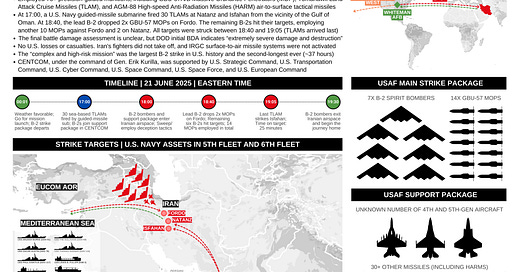




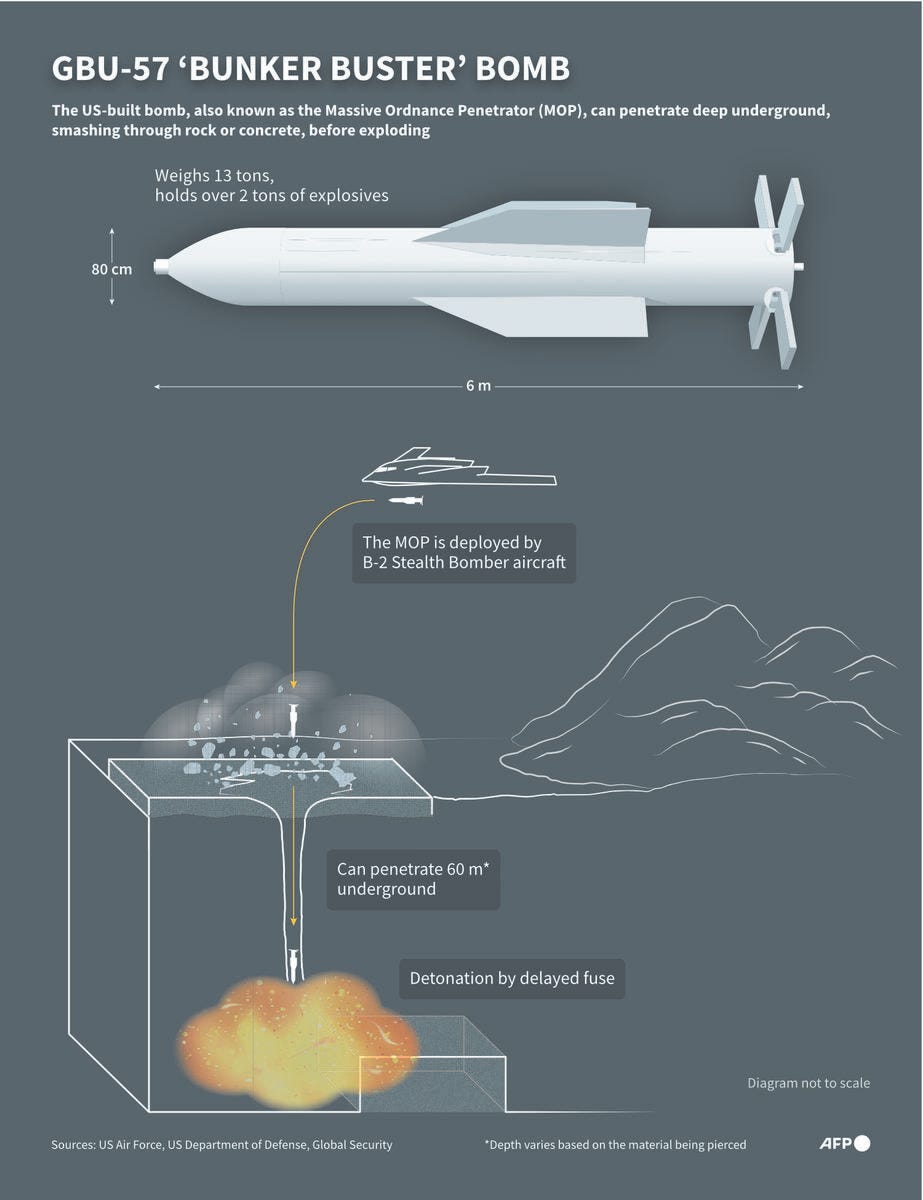



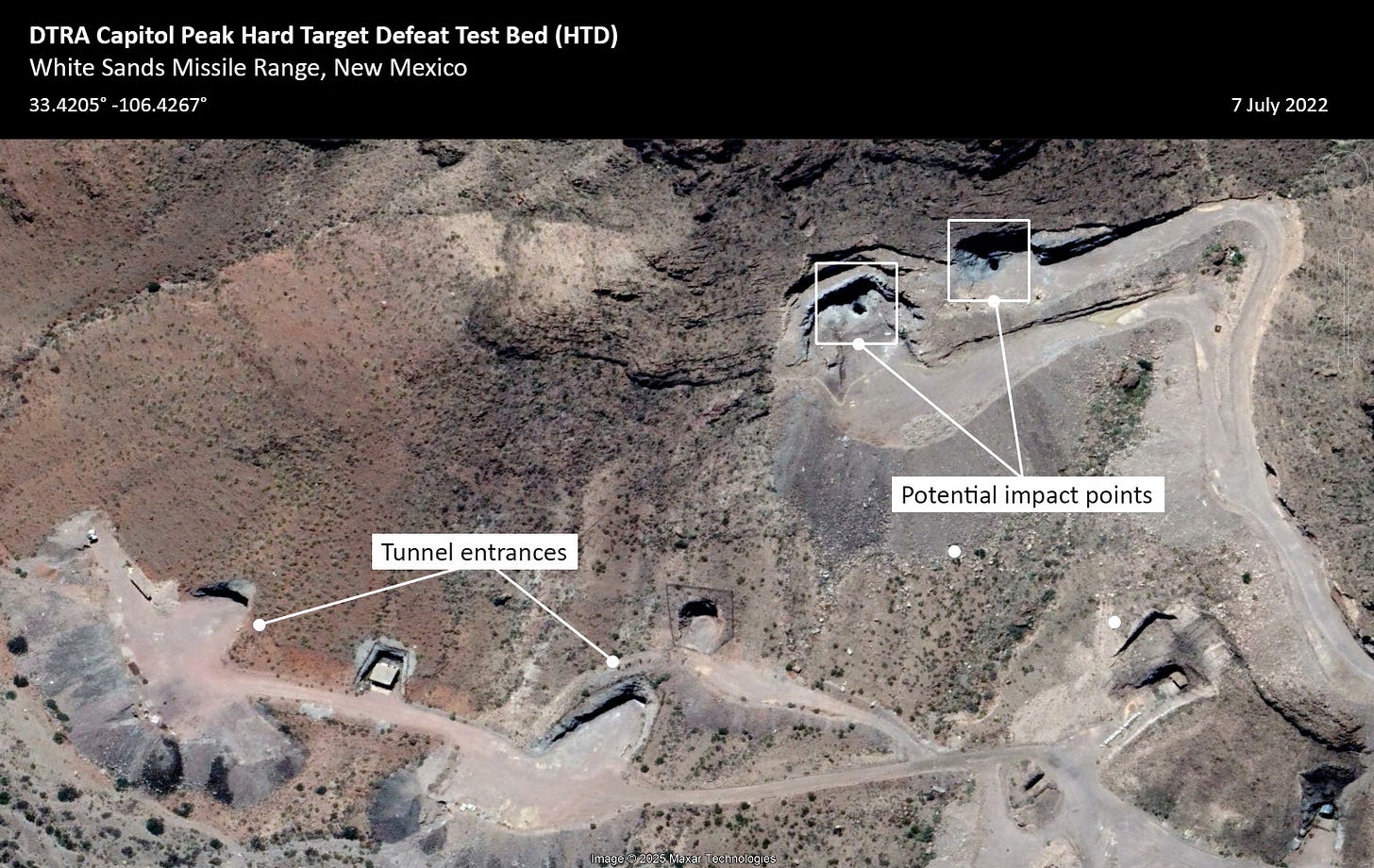

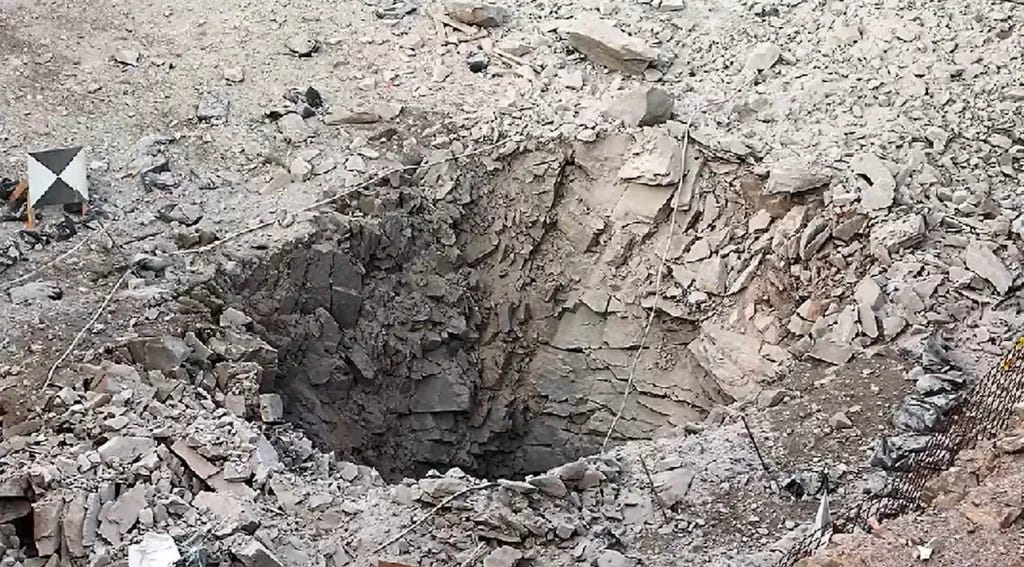
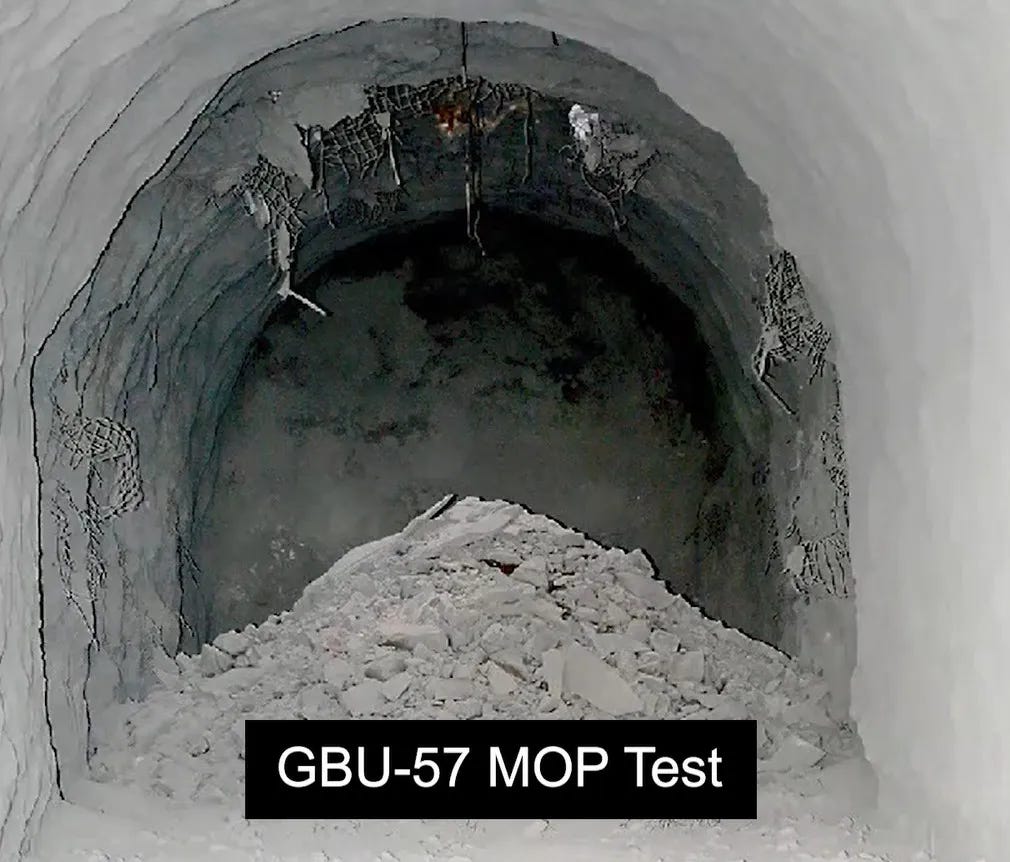
The collective intelligence of the collective West would be incapable of understanding your assessment. Regardless, it's brilliant. . . thank you.
Excellent and detailed information and analysis as usual, which if I understood it correctly, means that while some shallow damage was inflicted on entrances and ventilation shafts, it is unlikely any substantive damage was inflicted on Iranian nuclear capability.
The thought of Trump having the nous or attention span to read this level of analysis is amusing.